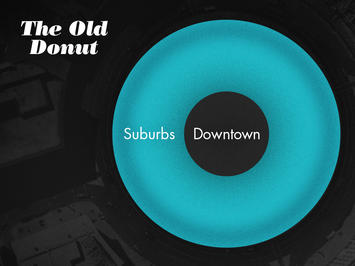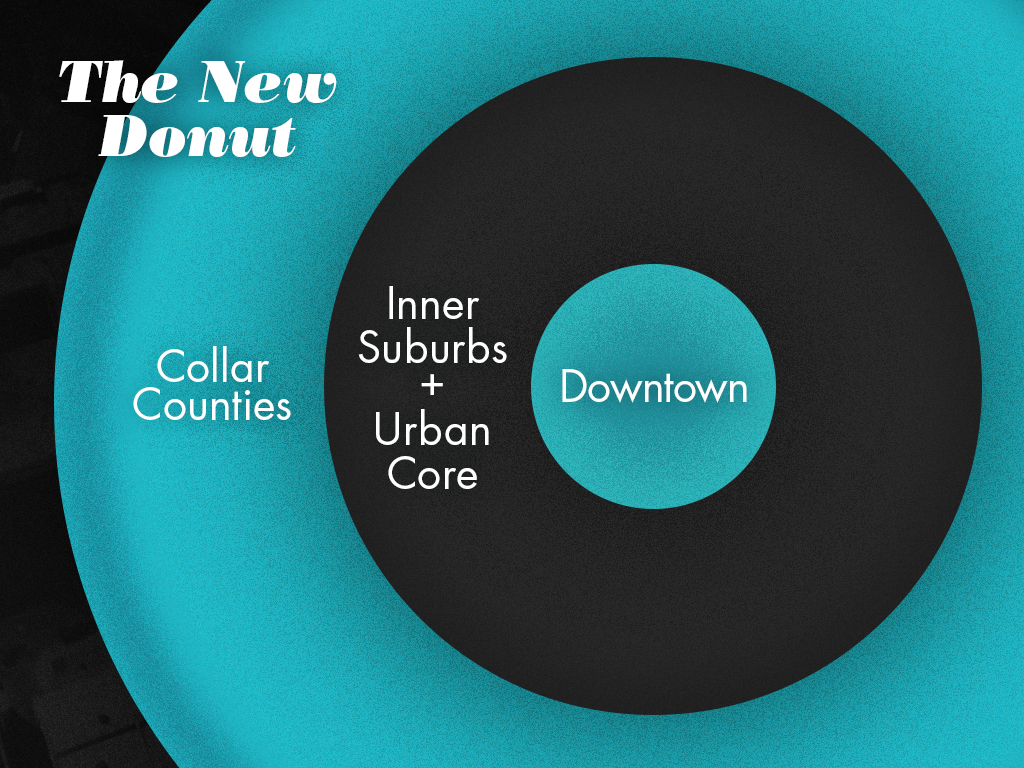
Former Indianapolis Mayor Bill Hudnut used to like to say that “you can’t be a suburb of nowhere.” This is the oft-repeated notion has been a rallying cry for investments to revitalize downtowns in America for three decades or so now. The idea being that you can’t have a smoking hole in your region where your downtown is supposed to be. This created a mental based on a donut. You can’t let downtown become an empty hole. For reason that will become apparent soon, I call this model “the old donut”.
Filling in the hole became every city’s mission. Pretty much any city or metro region of any size has pumped literally billions of dollars into its downtown in an attempt to revitalize them. This took many forms ranging from stadiums to convention centers to hotels to parking garages to streetcars to museums and more. It’s popular today to subsidize mixed use development with a heavy residential component.
These efforts have paid off to a certain degree. Most big city downtowns have done very well as entertainment and visitor districts, eds and meds centers, etc. More recently we’ve seen an influx of residents, even in places where the overall city or even region has struggled or declined. Cleveland added about 4,000 net new downtown residents in the 2000s. St. Louis added 3,000. With most cities in some stage of an apartment building spree consisting of a few thousand units, these numbers should only improve.
Key weaknesses remain in private sector employment (declining in most places) and retail (not enough high income residents yet). And other than the tier one types of cities like Chicago, few places seem to have reached a sustainable market rate development level yet – pretty much everything is getting public assistance. Yet its pretty evident that most larger downtowns have made huge strides and are experiencing overall reasonable health.
In short, the donut hole has been filled in. Where does that leave us? I’d argue with a paradigm I call “the new donut”:

In this model, the old donut is inverted. What used to be the ring of health – the outer areas of the city and the inner suburban regions – are now struggling. Whereas the downtown is in pretty good shape, and the newer suburban areas are booming. (You might add in a fourth outer ring with troubles – these were the exurbs where very low-end housing proliferated because development standards were very low).
You see this in the population figures. Wendell Cox cranked the numbers and found that major metro areas gained 206,000 residents in the two mile radius from the center, but lost 272,000 residents from the 2-5 mile ring. Growth picked up strongly beyond that arc. This is the new donut area, though the start and end of it vary by metro and some have thicker rings of challenge than others.
We’ve got three decades of experience in downtown revitalization, but much less in dealing with this newer challenge zone. I’ve said that suburban revitalization may prove to be the big 21st century “urban” challenge. This is where it is happening in many cases. These areas have an inferior housing stock (often small post-war worker cottages or ranches), sometimes poor basic infrastructure, and are sometimes independent municipalities that, like Ferguson, MO, are often overlooked unless something really bad happens. Unlike the major downtown, they are often “out of sight, out of mind” for most regional movers and shakers.
What’s more, while downtown provides a concentrated location for massive public investment, this more spread out area is too big to fix by throwing money at it. And how many stadiums and convention centers does a region need in any event?
This is where we need to be doing a lot of thinking about how to bring these places back, look at what’s being done, etc. And also, given the inequality in the country, to try to think about ideas that don’t involve gentrification. One project that appears to be in this kind of zone, for example, is Atlanta’s Beltline project, though there’s a gentrifying aspect to this one. Regions that figure this one out will be at a big advantage going forward.
Aaron M. Renn is an independent writer on urban affairs and the founder of Telestrian, a data analysis and mapping tool. He writes at The Urbanophile, where this piece originally appeared.













The Toronto Story
Good stuff. A few notes and ideas wrt Toronto. First, since we are on the lake (Ontario), Toronto is more croissant than donut. But, the pattern is the same. And, it's worth noting that it is the "new donut" that elected Rob Ford Mayor. So, this is an area that has been getting a lot of attention.
David Hulchanski's "Three Cites" report was one of the first to quantify this. http://www.urbancentre.utoronto.ca/pdfs/curp/tnrn/Three-Cities-Within-To...
Also, some of my own work when I was at the Martin Prosperity Institute, links much of this to transit. http://martinprosperity.org/images/stories/jmc/cache/mpi-transit-deserts...
Really, it's about infrastructure. These "near suburbs" are places that were outside the city core, were often separate municipalities, and had their own governance structures -- often they were conservative places that wanted low taxes more than anything else. Think about that dynamic -- you have a central city with a more liberal government and people with needs for services getting those services off the higher commercial property tax revenues generated in the central cities (also look at what happened in the 70's and 80's to some of these cities NYC, Philly, others when that collapsed). But, the "near suburbs" kept their taxes low and didn't have to provide these services because the central city did. "We don't have homeless people in XXXville -- they are all downtown -- so we don't need to build shelters. Besides, shelters just attract homeless people." As a result these "new donut" places never invested in serious infrastructure or services.
Now that downtowns are popular and gentrified/gentrifying because of time savings, amenities, productivity gains, etc. Lower income people are ending up in the near suburbs as the affordable location for them. Bad transit, low connectivity, few services, no wonder they are affordable. And, no wonder that the people who are living there, many of who have been displaced from downtown, are unhappy. Toronto is rife with stories about people who end up spending 2 hours on multiple buses, streetcars, and subways just to get to work. And, it's because where they live has very low connectivity. And, they are in the "new donut".
What makes Toronto the interesting example is that in 1998 a conservative provincial government under the guise of efficiencies (none of which have materialized) but really to dilute the voting pool and make Toronto less liberal -- in fact, making a Mayor Rob Ford possible -- amalgamated Toronto with the nearest suburbs and creating a new city of Toronto. So Toronto is now a single city with both the "hole" and the "new donut". It actually has some positive impacts. The city has to own up to the situation and it helps to avoid the Detroit situation. http://martinprosperity.org/media/Detroit-Chicago-Toronto-Insight_v01.pd...